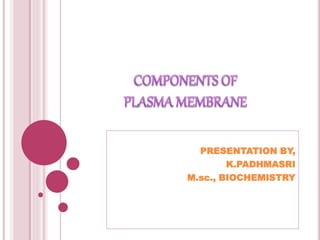
Components of plasma membrane
- 2. CHEMICAL COMPONENTS OF PLASMA MEMBRANE Chemical composition the membranes are composed of lipids, Proteins and carbohydrates The actual composition differs from tissue to tissue. Among the lipids, amphipathic lipids (containing hydrophobic and hydrophilic groups) namely phospholipids, glycolipids and cholesterol, are foundin the animal membranes
- 4. LIPIDS Lipids are the basic structural components of cell membranes. Lipid molecules have a ‘polar’ or ionic head hence hydrophilic the other end is a ‘nonpolar’ and hydrophobic tail. Hence they are amphiphatic
- 5. TYPES OF LIPIDS PRESENT IN BIOMEMBRANES • 1. Fatty acids: They are major components of most membrane lipids. The nonpolar tails of most membrane lipids are long chain fatty acids attached to polar head groups The degree of unsaturation determines the fluidity of the membranes • 2. Glycerophospholipids: They are another group of major components of biomembranes. Phosphatidylethanol amine (cephalin), phosphatidylcholine (Lecithin) and phosphatidylserine are among the most of common glycerophospholipids3-P.
- 6. 3. Sphingolipids: They comprise another group of lipids found in biological membranes specially in the tissuesof nervous system. There are three types of sphingolipids Sphingomyelin, cerebrosides and gangliosides. 4. Cholesterol: Cholesterol is another common component of the biomembranes of animals but not of plants and prokaryotes. It is oriented with its hydrophilic polar heads exposed to water and its hydrophobic fused ring system and attached hydrocarbon groups buried in the interior. Cholesterol helps to regulate fluidity of animal membranes
- 8. PROTEINS Proteins: Main types of membrane proteins are 1. Integral membrane proteins (also called intrinsic membrane proteins): These proteins are deeply embedded in the membrane. Thus portions of these proteins are in Vander Waals contact with hydrophobic region of the membrane. 2. Peripheral membrane proteins (also called extrinsic These may be weakly bound to the surface ofthe membrane by ionic interactions or by hydrogen bondsthat form between the proteins and the ‘polar’ heads of the membrane lipids. They may also interact with integral membrane proteins. They can be removed without disrupting the membrane.
- 9. 3. TRANSMEMBRANE PROTEINS: Some of the integral proteins span the whole breadth of the membrane and are called as transmembrane proteins. The hydrophobic side chains of the amino acids are embedded in the hydrophobic central core of the membrane. These proteins can serve as receptors for hormones, neurotransmitters, tissue ,specific antigens, growth factors, etc
- 10. (C) CARBOHYDRATES : Occurs in cell membranes and in Lipoproteins. Approximately 5 per cent of the weight of cell membranes is carbohydrate, in the form of glycoproteins and glycolipids. The presence on the outer surface of the plasma membrane, the glycocalyx, has been shown with the use of plant lections, protein agglutinins that bind specific glucosyl residues
- 11. GLYCOPROTEIN glycoprotein of human erythrocytes. It has 130 amino acid residues and spans the lipid membrane, with polypeptide regions outside both the external and internal(cytoplasmic) surfaces. Carbohydrate chains are attached to the amino terminal portion outside the external surface. Carbohydrates are also present in apoprotein B of plasma lipoproteins. The carbohydrate chains of many glycoproteins show structural variation from one molecule to another, a phenomenon known as microheterogeneity
- 12. FORMATION OF LIPID BILAYER Membrane glycerophospholipids and sphingolipids spontaneously form bilayers, whiLipid bilayers are oriented with their hydrophobic tails inside the bilayer while hydrophilic ‘polar’ heads are in contact with the aqueous solution on each side. Not all lipids can form bilayers. A lipid bilayer can form only when the cross-sectional areas of the hydrophobic tail and hydrophilic polar head are about equal. Glycerophospholipids and sphingolipids fulfil this criteria and hence can form bilayer. polar heads are too large, similarly cholesterol also cannot form bilayers as the rigid fused ring systems and additional nonpolar tails are too large ch is the basis of living biological membranes.
- 13. LIPID BILAYER The hydrophobic effect and the solvent entropy provide the driving force for the formation of lipid bilayer. A lipid bilayer is about 6 nm and thin that it may be regarded as a two-dimensional fluid. Lipid molecules in a bilayer are highly oriented
- 14. FLUID MOSAIC MODEL The fluid mosaic model of membrane structure proposed by Singer and Nicholson in 1972 is now accepted widely.
- 15. FLUID MOSAIC MODEL The membrane proteins, intrinsic proteins (integral)deeply embedded and peripheral proteins loosely attached, float in an environment of fluid phospholipid bilayers. It can be compared like icebergs floating in sea specific integral proteins in the plasma membrane of an interspecies hybrid cell formed by the artificially induced fusion of two different parent cells. It has subsequently been shown that it is not only the integral proteins, the phospholipids also undergo rapid redistribution in the plane of the membrane. This diffusion within the plane of the membrane is termed translational diffusion. It can be quite rapid for a phospholipid molecule. Within the plane of the membrane, one molecule of phospholipid can move several micrometers per second. The phase changes, and thus the fluidity of the membrane are highly dependant upon the lipid composition of the membrane.